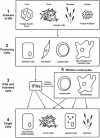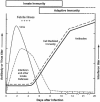Biological and clinical basis for molecular studies of interferons
- PMID: 16007741
- PMCID: PMC7121562
- DOI: 10.1385/1-59259-939-7:001
Biological and clinical basis for molecular studies of interferons
Abstract
The cytokine family of interferons (IFNs) has multiple functions, including antiviral, anti-tumor, and immunomodulatory effects and regulation of cell differentiation. The multiple functions of the IFN system are thought to be an innate defense against microbes and foreign substances. The IFN system consists first of cells that produce IFNs in response to viral infection or other foreign stimuli and second of cells that establish the antiviral state in response to IFNs. This process of innate immunity involves multiple signaling mechanisms and activation of various host genes. Viruses have evolved to develop mechanisms that circumvent this system. IFNs have also been used clinically in the treatment of viral diseases. Improved treatments will be possible with better understanding of the IFN system and its interactions with viral factors. In addition, IFNs have direct and indirect effects on tumor cell proliferation, effector leukocytes and on apoptosis and have been used in the treatment of some cancers. Improved knowledge of how IFNs affect tumors and the mechanism that lead to a lack of response to IFNs would help the development of better IFN treatments for malignancies.
Figures




References
-
- Isaacs A. Interferon. In: Smith K. M., Lauffer M. A., editors. Advances in Virus Research. New York: Academic Press, Inc.; 1963. pp. 1–35.
-
- Baron S. Mechanism of recovery from viral infection. In: Smith K. M., Lauffer M. A., editors. Advances in Virus Research. New York: Academic Press, Inc.; 1963. pp. 39–64. - PubMed
-
- Dianzani F., Baron S. Nonspecific defenses. In: Baron S., editor. Medical Microbiology. Galveston, TX: The University of Texas Medical Branch at Galveston; 1996. pp. 1–624. - PubMed
-
- Baron S., Coppenhaver D. H., Dianzani F., et al. Interferon: Principles and Medical Applications. Galveston, TX: The University of Texas Medical Branch; 1992. p. 624.
Publication types
MeSH terms
Substances
LinkOut - more resources
Full Text Sources
Medical
